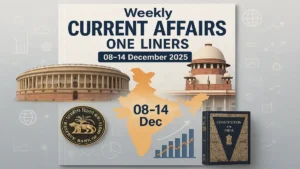RBI Monetary Policy June 2023
The RBI Monetary Policy meeting is held for June 2023. The Reserve Bank of India (RBI) declared its second instance of maintaining the interest rates at the same level, indicating successful outcomes from RBI monetary policy measures. RBI Governor Shaktikanta Das announced that the repo rate would remain unchanged at 6.5%. He further stated that India’s Consumer Price Index (CPI) inflation has decreased in recent months, and the GDP forecast for the current fiscal year remains unchanged.
Buy Prime Test Series for all Banking, SSC, Insurance & other exams
RBI Monetary Policy June 2023: Key Highlights
- The Monetary Policy Committee (MPC) expressed its worry regarding persistent inflation, which could be a concern due to uncertain monsoon patterns, fluctuations in global commodity prices, and volatility in the international financial markets.
- The Reserve Bank of India (RBI) estimated that the Consumer Price Index (CPI) inflation for the fiscal year 2024 would be around 5.1 percent. Additionally, the GDP growth rate for FY24 was projected to be 6.5 percent.
- In other developments, the RBI authorized banks to issue Rupay prepaid forex cards and expanded the usage of e-rupee vouchers for non-banking companies.
- The minutes of the MPC’s meeting will be made public on June 22.
- The Monetary Policy Committee (MPC) has announced that it will maintain the repo rate at 6.5%.
- The Standing Deposit Facility Rate remains at 6.25%, while the Marginal Standing Facility Rate and Bank Rate remain unchanged at 6.75%.
- All members of the MPC, including Dr. Shashanka Bhide, Dr. Ashima Goyal, Jayanth R. Varma, Rajiv Ranjan, Michael Debabrata Patra, and Shaktikanta Das, unanimously voted to keep the policy repo rate unchanged at 6.5% for the second time.
RBI Monetary Policy: CPI Inflation
The Reserve Bank of India (RBI) has projected the Consumer Price Index (CPI) inflation for the fiscal year 2024 to be 5.1%. Inflation is expected to remain above the RBI’s target of 4% throughout 2023-24 due to factors such as uncertainty in the monsoon season, international commodity prices, and financial market volatility.
Expressing concerns about rising inflation, the RBI Governor mentioned that inflation continues to pose a risk to the economy, considering the uncertainties mentioned earlier.
RBI Monetary Policy: GDP Growth Rate of India in 2023-24
The GDP growth rate for India in 2023-24 will be kept at 6.5% by the RBI MPC. On a quarterly basis, the GDP growth rate is projected to be 8% in Q1FY24, 6.5% in Q2FY24, 6% in Q3FY24, and 5.7% in Q4FY24.
The RBI assures that it will maintain liquidity management and ensure the orderly completion of the government’s market borrowing program within the specified timeframe.
Governor Shaktikanta Das stated that the MPC will take necessary monetary actions to anchor inflation expectations. Additionally, the real policy rate will remain positive, and the average system liquidity is still in surplus mode. It is expected to increase further as ₹2,000 banknotes are deposited in banks.
RBI Monetary Policy: Rupay prepaid Forex cards
The Reserve Bank of India (RBI) has authorized banks to issue Rupay prepaid forex cards. Additionally, the RBI has announced plans to expand the use of e-rupee vouchers, allowing non-bank companies to issue similar instruments independently.
Governor Shaktikanta Das emphasized that the RBI will actively monitor and address emerging risks to both price stability and financial stability.
RBI Monetary Policy: Net FPI inflow in FY24
According to RBI Governor Shaktikanta Das, the net inflow of Foreign Portfolio Investments (FPI) in the fiscal year 2023-2024 until June 6 amounts to $8.4 billion. In comparison, the net FPI inflow was $14.1 billion in 2021-2022 and $5.9 billion in 2022-2023.
RBI Monetary Policy: Surplus Liquidity
- The average daily borrowings through the liquidity adjustment facility (LAF) between April and May amounted to ₹1.7 lakh crore, indicating less surplus liquidity compared to the ₹2.9 lakh crore observed throughout the entire fiscal year 2022–23.
- Shaktikanta Das, the governor of the Reserve Bank of India (RBI), explained that various factors contributed to this reduction, including the maturity of targeted longer-term refinancing operations (TLTROs).
- Additionally, the seasonal increase in money circulation and the accumulation of government cash balances during this period helped moderate the excess liquidity.
- However, starting from the third week of May, the liquidity in the system increased due to higher government spending and a decrease in the amount of money in circulation.
- The RBI’s market activities and the deposit of ₹2,000 banknotes in banks further added to this liquidity increase.
- The presence of surplus liquidity and the higher utilization of the marginal standing facility (MSF) by some banks indicate an uneven distribution of liquidity within the banking sector.
- To address this situation, the RBI conducted two 14-day variable rate reverse repo (VRR) auctions in February and March 2023, each totaling ₹50,000 crore.
In order to take prompt action on liquidity, the Reserve Bank conducted several VRR auctions, including a 14-day auction on June 2 for ₹2.0 lakh crore, a 4-day auction on June 5 for ₹1.0 lakh crore, a 3-day auction on June 6 for ₹75,000 crore, and a 2-day auction on June 7 for ₹75,000 crore. However, the response to these auctions has been cautious.
Find More News on Economy Here




 Weekly Current Affairs One Liners 08th t...
Weekly Current Affairs One Liners 08th t...
 Which Indian City is Known as the Footwe...
Which Indian City is Known as the Footwe...
 Which Desert is known as the Cold Desert...
Which Desert is known as the Cold Desert...







